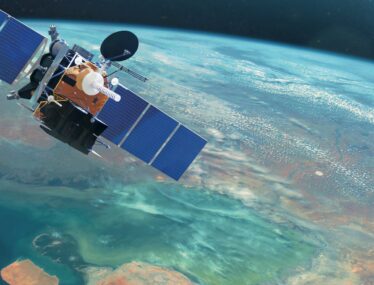Evolution in user terminal design for broadband from space
By Andrew Fell

New LEO satellite networks promise high-speed broadband access for billions living beyond the reach of fibre and cellular networks. But the cost of User Terminals (UTs) for such satellite connections remains far beyond consumer budgets. Andrew Fell sketches how technical innovation, convergence in standards and network intelligence could pave the road to low-cost UTs for broadband from space.
Traditionally, manufacturers of satellite terminals have struggled to bring UT prices down to consumer levels. This has been partly due to the complexity of terminals designed to work with highly proprietary protocols and system parameters unique to each satellite operator, but mostly it has been due to the overall small market size.
As the new low earth orbit (LEO) satellite networks will offer bandwidths and latencies more in line with the consumer expectations of today, a sizeable consumer market in areas beyond the reach of fibre and cellular broadband is waiting to be tapped. This will lead to much higher volumes than traditionally seen in the satellite sector, driving changes from the traditional approach and level of integration.
Low cost chipsets which include the radio, baseband and power supply elements of the design are now ubiquitous in the cellular industry, driven by consumer demand for high speed and high capacity data consumption. Many of the advanced techniques and technology used can be transferred to satellite communications, with some modification applicable to satellite specific aspects such as emissions, timing requirements and hand-over.
Although there are significant technical differences between Geostationary Earth Orbit (GEO) and LEO constellations, there is a large amount of commonality across the different types of platforms which may be met by a generic software-defined radio solution largely developed around existing cellular technology.
Over the coming years, as the mega-constellations are rolled out, we should expect to see an evolution in user terminal design: from highly bespoke, satellite operator-specific implementations, to fully integrated modems and smart antennas. This will be combined with intelligence in the satellite operator’s network to release the potential for low-cost design.
Some examples of this evolution are:
- Convergence of standards between constellation types and operator, enabling the technology to develop in a similar way to the cellular industry. 3GPP is already studying 5G New Radio support for non-terrestrial networks. This will enhance eco-system leveraging of higher volume chipset supply.
- Fully integrated chip design for software-defined radio with flexible, integrated digital signal processing, reducing cost and power consumption in the modem.
- Integration of the full modem functionality into the antenna itself, as opposed to separate modem and antenna head units.
- Power consumption reductions resulting from chipset integration and protocol optimisations.
- Smart antennas with multiple beam and/or multi band functionality that can quickly self-align and track the satellite constellation, reducing the significant installation and alignment cost particularly associated with GEO fixed services, or quickly following a LEO satellite as it flies overhead whilst looking for the next satellite in anticipation of hand-over.
- Integrated smart antennas, phased arrays and steerable antennas improving aesthetics and practicality (for example, flat panels for mounting on trains so they can go through tunnels)
- Beamformer silicon development; lowering cost, power consumption and improving performance for higher bandwidths.
- Evolving new techniques in smart electronically steered antennas, where we will likely see some new and interesting patents.
- Network intelligence used to relieve the User Terminal from terrestrial interference sources, satellite to satellite interference and to keep terminal power consumption to a minimum.
- Multi-carrier aggregation to provide even higher bandwidth services for enterprise solutions.
- Network to network coordination, providing traffic routing across constellation types and even operators, to alleviate blockages and optimise traffic routing
Not all of these changes will happen at once and indeed is a long term vision, but user terminals will evolve as the technology appears in the desired market sectors. Whist ‘connectivity to the unconnected’ still represents significant technical and commercial challenges, broadband delivery from space, at the right price point, is likely to offer the high-speed services that are so much in demand across the world’s population.



